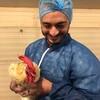Explore all the information on
Sow feeding management
An essential part of any strategy to optimize sow reproductive performance, increase efficiency of feed usage and lower culling rate, is to control weight and backfat gain during gestation and weight and backfat loss in lactation. This is best achieved by individually feeding each sow a well balanced diet, and basing daily feed allowances according to an estimate of sow bodyweight and backfat thickness.
A well-designed feeding program can help meet operational goals for sow farm efficiency and profit by minimizing feed waste and maximizing sow productivity. An effective sow feeding program starts with breeding gilts within the right window of weight and feeding them according to recommendations during their first gestation. This can help maximize the number of sows in ideal condition at first farrowing.
Additionally, knowing and maintaining an ideal sow body condition score is a key strategic area for long-term success. The body condition of sows in the barn is closely related to the profitability of the sow farm because it impacts sow longevity and reproductive performance. Keeping sows in the ideal body condition – not too fat and not too thin – is essential. A successful feeding program includes recording data and linking body condition to feeding so you can correctly adjust each sow’s feed ration.
Introduction: Sow body condition is a critical factor in all stages of the production cycle affecting health, welfare, performance and longevity. Additionally, the direct economic impact on annual costs of unoptimized feeding can be substantial. Therefore, it is important to monitor sows throughout their lifetime to ensure well-being, maximize production efficiency, optimize culling decisions and determine the adequacy of the feeding management practices. Multiple tools are...
Comments : 0
Recommendations: 0
Introduction Pigs suffer high rates of embryonic mortality, especially during the peri-implantation period of pregnancy [1, 2] when embryos elongate rapidly, signal for pregnancy recognition, and attach to the uterine wall [3, 4]. Maternal nutrition plays an important role in the development and subsequent survival of conceptuses (embryo/fetus and its extra-embryonic membranes), especially the maternal dietary intake of amino acids (AAs) [5–7]. Both low and high...
Comments : 0
Recommendations: 0
Introduction On average, piglet livability in Europe is 83%, ranging from 70% to 90%. It is determined by the number of still births and pre-weaning mortality in a given litter. With the increasing litter size, piglet survival is a persistent challenge to pig producers. This calls for a feeding and management strategy to improve nutrition and wellbeing of the sow in the transition phase covering late gestation, farrowing, lactation and breeding. The transition period...
Comments : 1
Recommendations: 0


APIs and Vitamin MARKET - The weak demand for the APIs
Suggested link
Introduction The major goal of the swine industry is to minimize neonatal mortality and improve weaning weights of neonatal pigs because their adaptability to weaning and their rates of growth to market weight are positively affected by weaning weight [1]. The total net profit of a swine production unit is primarily determined by both the number and size of piglets produced per year per sow [2]. Recent attempts to increase litter size have led to increased prevalence of...
Comments : 0
Recommendations: 0
The feed intake of sows is important, because sows are becoming more productive thanks to the continuous genetic improvements made by pig breeding companies. This increase in litter size leads to a huge burden on the sow to feed her litter. The objective of the sows is simple: to supply more milk - and for this purpose, they need to eat. Listen to Professor Bruno Silva from the Federal University of Minas Gerais in Brazil to know more!...
Comments : 1
Recommendations: 3


Growth performance of pigs (6-25 kg) fed diets supplemented with DL-methionine or liquid MHA-FA under commercial conditions in Mexico
Suggested link
Sekhou Cisse (Nor-Feed, France) presents his poster regarding the effect of this additive on microbiota modulation, during the Symposium on Gut Health in St. Louis, USA....
Comments : 0
Recommendations: 3
Chengbo Yang (University of Manitoba) comments on fermentation rate, use of enzymes and diet formulation with alternative ingredients, during the Symposium on Gut Health in St. Louis, USA....
Comments : 0
Recommendations: 1


Cordyceps militaris hot water extract inhibits lipopolysaccharide-induced inflammatory response in porcine alveolar macrophages by regulation of mitogen-activated protein kinase signaling pathway
Suggested link
Introduction: Over the last few years, the number of born and weaned piglets per sow has been increased continuously. The aim of this study was to investigate, whether a separate allocation of a high fiber diet in addition to an ad libitum feeding of sows in farrowing pens, leads to beneficial effects for sows and piglets. Materials and Methods: From day 109 (d-7) of gestation, a total of 34 sows were fed daily two portions of a commercial lactation...
Comments : 0
Recommendations: 0
Our sow cannot stand. Its back legs have no strength. It doesn't eat unless fed through a syringe. It's 1 week now since it became like paralyzed. It is 3 months and 15 days pregnant now. We have injected her antibiotics and vitamins but no effect. What should we do? ...
Comments : 4
Recommendations: 0
...
Comments : 0
Recommendations: 0
...
Comments : 0
Recommendations: 0
Bruno Silva (Universidade Federal de Minas Gerais) explains the need to adapt feeding programs to the characteristics of young and adult sows, during IPVS2022 in Rio de Janeiro, Brazil....
Comments : 0
Recommendations: 3
Bruno Silva (Universidade Federal de Minas Gerais) talks about what needs to be understood about the animal in order to use precision feeding, during IPVS2022 in Rio de Janeiro, Brazil. ...
Comments : 0
Recommendations: 0


APIs and Vitamin MARKET - The weak demand for the APIs
Suggested link
Ken Stalder (Iowa State University) discussed breeding and other topics during this Swine It interview with host Laura Greiner....
Comments : 0
Recommendations: 0
INTRODUCTION One of the greatest challenges in optimizing growth performance and health of newly weaned pigs is to overcome low and variable feed consumption which adversely affects gastrointestinal health during this critical transition period on commercial swine farms (Pluske et al., 1997; Langendijk et al. 2007; Dong and Pluske, 2007). Therefore, dietary interventions that encourage faster adaptation and greater feed consumption, while also improving energy and...
Comments : 1
Recommendations: 0


Growth performance of pigs (6-25 kg) fed diets supplemented with DL-methionine or liquid MHA-FA under commercial conditions in Mexico
Suggested link
Introduction: Clostridium perfringens is a gram-positive bacteria that can cause diarrhea and is commonly transferred from the sow to the piglet. The objective of this study was to evaluate dietary addition of a Saccharomyces cerevisiae fermentation product during late gestation through a 21 d lactation on sow and litter performance, milk components, and fecal Clostridium perfringens. Materials and Methods: On d 93 of...
Comments : 0
Recommendations: 0
Introduction As many production systems are transitioning from individual gestation stalls to different styles of group housing, there are new challenges for data collection in the gestation barn. Commonly referred to as electronic sow feeders (ESF), computerized feeding stations have been available for more than 30 years as a method used to control the variability of sow intake (Trottier and Johnston, 2001), and now are becoming a powerful tool for sow...
Comments : 0
Recommendations: 0


Cordyceps militaris hot water extract inhibits lipopolysaccharide-induced inflammatory response in porcine alveolar macrophages by regulation of mitogen-activated protein kinase signaling pathway
Suggested link
1. Introduction With increasing public awareness regarding pig welfare, gestating sow housing systems are currently changing around the world to group-housing. While the legislation on sows’ group-housing was adopted in 2001 in Europe, the new Canadian regulation was enacted in 2014. The Canadian Code of Practice for the care and handling of pigs requires that all newly built facilities or those undergoing renovation must house sows in groups during gestation, or provide...
Comments : 0
Recommendations: 0
Introduction The present work addresses the use of data in improving decision making and farm productivity, one of the aspects that has generated more interest in swine production in recent years. In the current review, the limitations of data management and recently developed strategies in this sector have been revised, together with the need for new technologies and their use in the evolution of the precision livestock farming concept. The importance of traditional...
Comments : 0
Recommendations: 0






.jpg&w=3840&q=75)




















